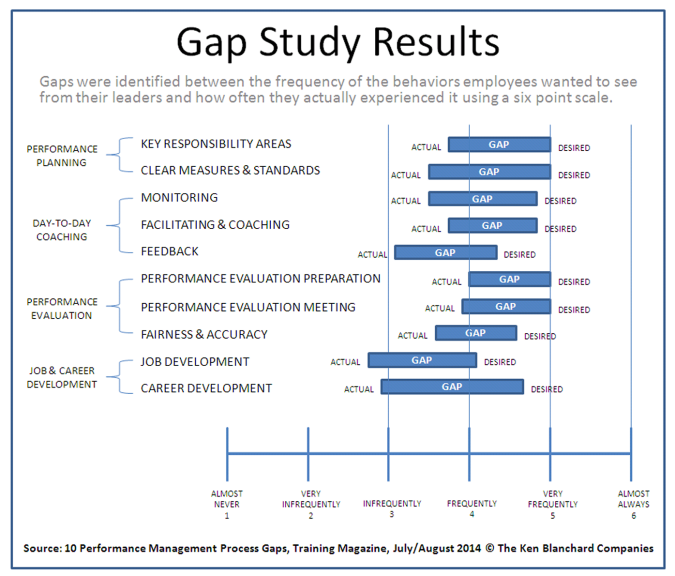Performance planning, coaching, and review are the foundation of any well-designed performance management system, but the results of a recent study suggest that leaders are falling short in meeting the expectations of their direct reports. A survey of 470 human resource and talent management professionals by Training magazine and The Ken Blanchard Companies found gaps of 24–39 percent between what employees wanted from their leaders and what they were experiencing in 10 key areas (see chart.)
Performance management is a key leadership responsibility. This survey suggests that significant gaps exist between employee expectations and what they are experiencing at work. Left unaddressed, these gaps represent a drain on overall organizational vitality through lowered employee intentions to stay, endorse, and apply discretionary effort as needed.
For leadership development professionals, these study results provide an opportunity to take a more targeted approach to improving perceptions in each of these areas. Here are four ways to get started.
- Take a look at the overall design of your performance management process. Are managers following best practices in setting goals that are specific, motivating, attainable, relevant, and trackable? What percentage of employees have current goals listed? Have leaders conducted an internal assessment to measure the degree to which employees feel that their goals are effective in directing and motivating their performance?
- Take a second look at the amount of time your managers are spending with their people. The Ken Blanchard Companies advocates that leaders meet with their direct reports a minimum of twice a month to discuss progress toward goals and address employee needs for direction and support. Monitoring progress and providing feedback are two of the key ways for a manager to stay involved and partner with an employee to achieve goals. Both activities directly influence improved performance.
- Review your performance review process. In many organizations, goals are set at the beginning of the year and not seen again until the review process at the end of the year. Blanchard has identified that a best practice is to conduct a series of mini-reviews throughout the year—every 90 days is the recommended standard. This allows leaders to make midcourse corrections, eliminates any surprises for individual employees, and keeps the partnership between manager and direct report strong and vibrant.
- Don’t forget job and career development. Growth opportunities at the job and overall career level are important drivers of employee work passion and one of the better ways that leaders can show team members that they care and are invested in them. Be sure that all performance review conversations include time for a discussion on ways that employees can improve their skills in their current role and also what the steps are that they can take to continue to advance in their careers.
A renewed focus on performance management can have significant results on the performance of an organization. Give your performance management system a review—and if you find similar gaps, address them for higher levels of employee work passion and performance.
To learn more about the research, read the complete article, 10 Performance Management Process Gaps (and How They Negatively Impact Employee Intentions) in the July/August issue of Training magazine.







